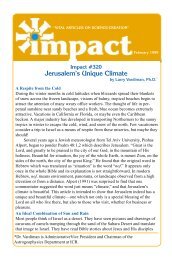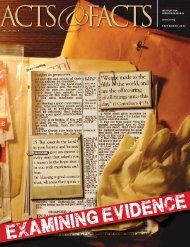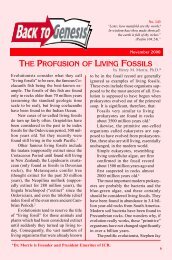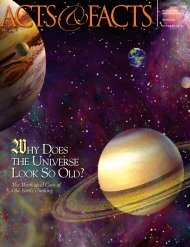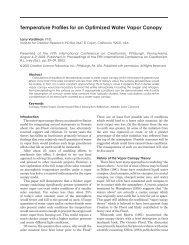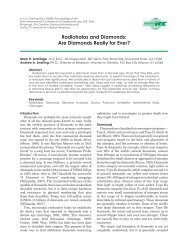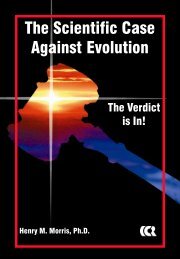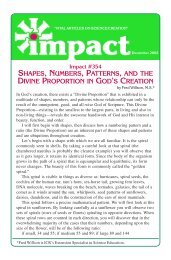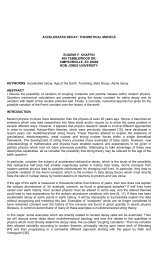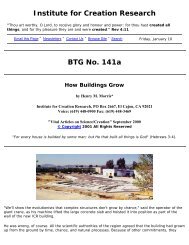Download September 2008 PDF - The Institute for Creation Research
Download September 2008 PDF - The Institute for Creation Research
Download September 2008 PDF - The Institute for Creation Research
Create successful ePaper yourself
Turn your PDF publications into a flip-book with our unique Google optimized e-Paper software.
ACTS&FACTSVOL. 37 NO. 9INSTITUTE FORCREATION RESEARCHwww.icr.orgSEPTEMBER <strong>2008</strong>Capitulatingon <strong>Creation</strong>Changing the truthof God into a lie
Available this fall exclusively from the <strong>Institute</strong> <strong>for</strong> <strong>Creation</strong> <strong>Research</strong>Earth’s Catastrophic Past:Geology, <strong>Creation</strong> & the FloodAndrew A. SnellingNew from the <strong>Institute</strong> <strong>for</strong> <strong>Creation</strong> <strong>Research</strong>, the long-awaitedupdate to <strong>The</strong> Genesis Flood!Written by long-time faculty member and ICR researcherAndrew Snelling—one of the world’s leading geologists in thecreation science movement—Earth’s Catastrophic Past providesup-to-date geological evidence that demonstrates the authorityand accuracy of the biblical account of creation and the Flood.For more in<strong>for</strong>mation, visit our website at www.icr.org/resources.
FROM THE PRESIDENTAn Interesting SightingCONTENTS4Capitulatingon<strong>Creation</strong>Lawrence E. FordGraduate students in the sciencestend to be an intriguing lot. Asa professor, I’ve met some trulyunique individuals, who often havevery interesting life histories. One ICR grad studenttold me how, be<strong>for</strong>e she had accepted Christas her Savior, she and friends traveled to Scotlandin hopes of seeing the elusive Loch Ness Monster.One morning just after breakfast in a lodge by theloch, she looked idly out the window. I’ll let hertell the story.Suddenly I saw something—really sawsomething—that I’d been vaguely aware of<strong>for</strong> the last few minutes. I jumped up, almostspilling my coffee, and called <strong>for</strong> mycompanions to come see what I was seeing,swimming along out there, below us in thelake. It wasn’t just one, it was four large bulbousbeasts swimming along together!...Becauseof their size and the fact that while theywere traveling together along parallel pathsbut obviously swimming independently, wedetermined we had found the object of ourquest, the Loch Ness Monster….<strong>The</strong> “swimmers” appeared to be of differentlengths; the largest was perhaps between 15and 20 feet, and the smallest probably halfthat….<strong>The</strong> heads were small and barelyabove the water, but far enough out in frontof each “swimmer” to guesstimate the necklengths at from 1-1/2 to 2 feet <strong>for</strong> the smallone, and 4 to 5 feet <strong>for</strong> the largest one. <strong>The</strong>bodies appeared to be slightly elongatedovals, fatter in the middle, with flexiblenecks.<strong>The</strong>y swam slowly south towards the FortAugustine end of the lake, about 100-250 feetaway from the western lakeshore where wewere watching from the lodge window, approximately200 feet above the water. We hadbeen watching <strong>for</strong> several minutes when theysuddenly stopped. Glancing further southwe saw the reason, a fishing boat from FortAugustine was heading right at the “swimmers.”<strong>The</strong>y remained right where they hadstopped swimming, until the boat chuggedto within about 1/4 mile or so. <strong>The</strong>n, all atonce and all together, they sounded, and wenever saw them again.I make no pretense of claiming that thisstory is true, but I do vouch <strong>for</strong> the lady, a soberand honest woman. As you know, virtually hundredsof eyewitness accounts have surfaced overthe years of an unknown something in the loch.Serious scientific teams have attempted to solvethe mystery, but with few concrete results.All I know is that it would be wonderful todiscover a living relic of the long ago past. Evolutioninsists that large reptiles like the plesiosaurswent extinct some 65 million years ago. <strong>Creation</strong>holds that they mostly died in the great Flood ofNoah’s day, but what if some survived in isolatedpockets like the deep, cloudy Loch Ness?Such a discovery would not disprove evolution,since that nebulous hypothesis would morphto accommodate any observation. Nor would itprove creation. Neither view rises or falls on thispoint, but having said that, I would certainly liketo find one. <strong>Creation</strong> could certainly account <strong>for</strong>the existence of such a creature far better thanevolution could.John D. Morris, Ph.D.President6Meteorite89AnalysisBeginsLarry Vardiman, Ph.D.Man of Science,Man of God:James Clerk MaxwellChristine DaoNational <strong>Creation</strong>Science FoundationWerner Arber: Nobel10 Laureate, Darwin SkepticJerry Bergman, Ph.D.13<strong>The</strong> Mythical HorseSeriesJohn D. Morris, Ph.D.Evolution Continues to14 Be a Hard CellFrank Sherwin, M.A.15Empiricism: A GlaringFlaw of New AtheismBrian Thomas, M.S.Letters to the Editor16 Radio Log1719Profitable LaborHenry M. Morris IVBook Review: Persuadedby the EvidenceFrank Sherwin, M.A.Published by<strong>Institute</strong> <strong>for</strong> <strong>Creation</strong> <strong>Research</strong>P. O. Box 59029, Dallas, TX 75229214.615.8300www.icr.orgExecutive Editor: Lawrence E. FordManaging Editor: Beth MullAssistant Editor: Christine DaoDesigner: Dennis DavidsonPresident: John D. Morris, Ph.D.No articles may be reprinted inwhole or in part without obtainingpermission from ICR.SEPTEMBER <strong>2008</strong> • ACTS&FACTS3
Changing the truth of God into a lieL A W R E N C E E . F O R D4 ACTS&FACTS • SEPTEMBER <strong>2008</strong>Afew weeks ago, two local seminarystudents stopped by the ICR headquartersin Dallas. One of them, aTh.M. student, regularly receivesour Acts & Facts magazine. As I showed themaround, we chatted about seminary life, professorswe knew, and getting through the rigorsof coursework in preparation <strong>for</strong> ministry.When one student saw the newest ICRfossil acquisitions—the enormous skulls of amosasaur and a phytosaur—he told me thatduring the study of Genesis in his Old Testamentclass, he mentioned to the teacher thatdinosaurs and men had lived together and thatNoah took dinosaurs on the Ark. He didn’texpect the chuckles he received from his classmates,however.“Are you serious?” the professor askedhim.“Of course,” the student replied. “It’swhat the Bible describes.”“Son, I am an Old Testament scholar,”declared the professor, “and that’s not what theBible says.”When I heard this account, I was saddened.Similar episodes are occurring on seminarycampuses across the United States. In fact,the number of Bible colleges, seminaries, andChristian universities that have abandoned theplain-sense reading of Scripture is increasing atan alarming rate as more and more academiciansin Christian higher education acquiesceto hybrid theories that seek to “unify” Scripturewith evolutionary processes.<strong>The</strong> same is happening in local churcheswhere members challenge their pastors andteachers regarding the literal reading of Genesis1-2. Inundated as we are with the beautifulphotography of National Geographic, DiscoveryChannel programs, and PBS’s Nature, whocould argue <strong>for</strong> something as “unscientific” asthe Bible?More disturbing are the Christian leaderswho allow science to govern their interpretationof Scripture, touting “new discoveries”that “prove” evolutionary claims, and treatingthe Genesis account as a mere framework <strong>for</strong>expressing the fact that God created, ratherthan as a narrative relating the actual details ofGod’s work during the creation week.Can there be unity between creationand evolution? Did God just get life going andlet evolution take over? Six days or six billionyears—does it matter?Some would say that it does notmatter, that it’s not an “essential” ofthe faith. <strong>The</strong>re are, in fact, born againbelievers who do not believe in a literalreading of Genesis 1-2. Are we to questiontheir faith?Not necessarily. But the contradictionswith which these individuals must live shouldjar them into coming to terms, once and <strong>for</strong>all, with whether they believe in the accuracyand authority of God’s Word. If the Bible is infact authored by God, the Creator of life, thenthose who doubt God’s writings are burdenedwith proving that science—based on humantheories—explains the origin of life better thanScripture.In the introduction to <strong>The</strong> Battle <strong>for</strong> theBeginning, Dr. John MacArthur wrote thesestartling words about how naturalistic sciencehas infiltrated the church:Many who should know better—pastorsand Christian leaders who defend thefaith against false teachings regularly—have been tempted to give up the battle<strong>for</strong> the opening chapters of Genesis. Anevangelical pastor recently approachedme after I preached. He was confusedand intimidated by several books he hadread—all written by ostensibly evangelicalauthors—yet all arguing that the earthis billions of years old. <strong>The</strong>se authors treat
most of the evolutionists’ theories as indisputablescientific fact. And in somecases they wield scientific or academiccredentials that intimidate readers intothinking their views are the result of superiorexpertise, rather than naturalisticpresuppositions they have brought to thebiblical text. 1Not mincing words when it comes tothose who would elevate science over Scripture,MacArthur laments the drift amongevangelicals toward compromise:<strong>The</strong> evolutionary lie is so pointedly antitheticalto Christian truththat it would seem unthinkable<strong>for</strong> evangelical Christiansto compromise with evolutionaryscience in any degree.But during the past centuryand a half of evolutionarypropaganda, evolutionists have had remarkablesuccess in getting evangelicalsto meet them halfway. Remarkably, manymodern evangelicals…have already beenconvinced that the Genesis account ofcreation is not a true historical record.Thus they have not only capitulated toevolutionary doctrine at its starting point,but they have also embraced a view thatundermines the authority of Scripture atits starting point. 2If the Bible is in fact authored by God, then those whodoubt God’s writings are burdened with proving thatscience explains the origin of life better than Scripture.This capitulation is beginning to creepinto many areas of Christian ministry. At ourseminars, Christian educators express frustrationat having to use evolution-based textbooksin their classrooms. Science materialsthat teach the Big Bang and other evolutionaryprocesses are being sold at homeschool conventions.Sunday school and Bible study materialsare sometimes laced with teachings thatfavor the Gap <strong>The</strong>ory, <strong>The</strong>istic Evolution, Progressive<strong>Creation</strong>, and other hybrid attemptsto wed God and evolution within the sacredconfines of the church.Of course, this is not to suggest that theentire church has been lost to compromise.<strong>The</strong>re are still many pastors who unashamedlyuphold the integrity of Scripture from theirpulpits every Sunday. But pressure is mountingon ministers to give science even more influence.Is this an issue that affects your localchurch? Consider this fact: Since 2004, nearly12,000 pastors throughout the U.S. have signeda statement rejecting the biblical doctrine ofcreation. Called “An Open Letter ConcerningReligion and Science,” it states:Within the community of Christianbelievers there are areas of dispute anddisagreement, including the proper wayto interpret Holy Scripture. While virtuallyall Christians take the Bible seriouslyand hold it to be authoritative in mattersof faith and practice, the overwhelmingmajority do not read the Bible literally, asthey would a science textbook. Many ofthe beloved stories found in the Bible—the <strong>Creation</strong>, Adam and Eve, Noah andthe ark—convey timeless truths aboutGod, human beings, and the proper relationshipbetween Creator and creationexpressed in the only <strong>for</strong>m capable oftransmitting these truths from generationto generation. Religious truth is ofa different order from scientific truth. Itspurpose is not to convey scientific in<strong>for</strong>mationbut to trans<strong>for</strong>m hearts.We the undersigned, Christian clergyfrom many different traditions, believethat the timeless truths of the Bible andthe discoveries of modern science maycom<strong>for</strong>tably coexist. We believe that thetheory of evolution is a foundationalscientific truth, one that has stood up torigorous scrutiny and upon which muchof human knowledge and achievementrests. To reject this truth or totreat it as “one theory amongothers” is to deliberately embracescientific ignorance andtransmit such ignorance toour children. We believe thatamong God’s good gifts arehuman minds capable of criticalthought and that the failure to fullyemploy this gift is a rejection of the willof our Creator. To argue that God’s lovingplan of salvation <strong>for</strong> humanity precludesthe full employment of the God-given facultyof reason is to attempt to limit God, anact of hubris. We urge school board membersto preserve the integrity of the sciencecurriculum by affirming the teaching ofthe theory of evolution as a core componentof human knowledge. We ask thatscience remain science and that religionremain religion, two very different, butcomplementary, <strong>for</strong>ms of truth. 3Many of these same 12,000 ministers devoteone weekend every February to exalt theperson and work of Charles Darwin, whosebirthday falls on February 12. <strong>The</strong> next “EvolutionWeekend” will be held February 13-15,2009. You can be sure that this, the celebrationof Darwin’s 200th birthday, will be the grandestevolution party ever.Perhaps it’s time to find out whether thebook stocked in your church’s pews is <strong>The</strong> Originof Species or the Holy Bible.References1. MacArthur, J. 2001. <strong>The</strong> Battle <strong>for</strong> the Beginning: <strong>The</strong> Bible on<strong>Creation</strong> and the Fall of Adam.Nashville, TN: Thomas Nelson,18.2. Ibid, 25.3. For more in<strong>for</strong>mation, visitthe Clergy Letter Projectwebsite at www.butler.edu/clergyproject/rel_evol_sun.htm.Mr. Ford is Executive Editor.SEPTEMBER <strong>2008</strong> • ACTS&FACTS5
RESEARCHMeteorite Analysis BeginsLarry Vardiman, P h . D .When ICR’s Radioisotopes andthe Age of the Earth (RATE)study ended in 2005, severalprojects had not been completed.Among these were studies on meteorites,additional carbon-14 work on diamonds,and expanded sampling of helium in zircons.After a few years’ delay, we have begun to followup on these remaining projects.In spring <strong>2008</strong>, the 7-pound chondriticmeteorite shown in the accompanying picturewas purchased <strong>for</strong> meteorite studies. <strong>The</strong> meteoritewas found in the Sahara Desert in 1998and sold by a commercial Paris vendor to ICR<strong>for</strong> our analysis. Dr. Andrew Snelling is the principalinvestigator (PI) <strong>for</strong> the meteorite projectand plans first to obtain mineralogical analysesand make a thin section that he can examineMeteorite to be analyzed by RATE scientists.Photo by Larry Vardiman.through a microscope to determine the typesand relative amounts of the different mineralsit contains. He then plans to send most ofthe remaining portion to various commerciallaboratories to measure isotope ratios in severalof the minerals.Our hope is that the results of these laboratoryanalyses will indicate that the differentminerals comprising the meteorite contain ratiosof radioactive parent and daughter elementsthat are sufficiently different from one anotherthat isochron studies can be done like thosepreviously completed on basalts, granites, andother rocks in the RATE program. We desire todetermine whether similar accelerated nucleardecay processes have occurred in meteorites inspace as have been demonstrated to occur inminerals on earth. Because the conventional4.5-billion-year age of the earth is based on isotopicstudies on meteorites, it is important thatthis study be completed to complement whatwas previously found in RATE.Also in spring <strong>2008</strong>, Dr. John Baumgardner,PI <strong>for</strong> the carbon-14 project, beganworking with a second laboratory to continuethe study of carbon-14 in diamonds. <strong>The</strong> techniqueof analyzing diamonds <strong>for</strong> carbon-14has improved with a new process of insertingsmall portions of diamonds directly into theAccelerator Mass Spectrometer instead of firstgrinding them into tiny chips and combustingthem. <strong>The</strong> new process reduces the possibilityof contamination and provides more confidencein the measured levels of carbon-14. ICRhas purchased additional diamonds <strong>for</strong> thesenew analyses. Dr. Baumgardner hopes to gaindeeper insight into the means by which the carbon-14with its very short half-life came to existinside the diamonds.<strong>The</strong> search <strong>for</strong> additional deep cores ingranite from which zircons can be extracted <strong>for</strong>helium content and diffusion is scheduled tobegin in 2009. We hope to find one or two newsites in different locations from which we canobtain samples to replicate the earlier RATEresults. We don’t anticipate that the results willbe different, but believe it is important to demonstratethat our results <strong>for</strong> the original corefrom New Mexico will occur in other settingselsewhere in the world.If you are interested in these researchprojects but have not yet read the originalRATE report, you may wish to obtain a copy ofour book Radioisotopes and the Age of the Earth,Vol. II: Results of a young-earth creationist researchinitiative. It can be ordered through the ICRwebsite at www.icr.org/store, or by calling800.628.7640.Dr. Vardiman is Director of<strong>Research</strong>.6 ACTS&FACTS • SEPTEMBER <strong>2008</strong>
EVENTSSEPTEMBER-OCTOBER <strong>2008</strong> EVENTSSEPTEMBER 14Dennis, TX – Genesis Presentation(Sherwin) 817.613.9295SEPTEMBER 19-21Granville, NY – Genesis Presentations(Sherwin) 518.642.2219SEPTEMBER 24-26Myrtle Beach, SC – Southeast Christian School Convention(Sherwin) 919.731.4844OCTOBER 2-3Colorado Springs, CO – ACSI ConventionOCTOBER 2-3Portland, OR – ACSI ConventionOCTOBER 2-3South Bend, IN – ACSI ConventionOCTOBER 4Calistoga, CA – Rock of Ages Festival(Wood) 707.963.9115OCTOBER 4-5Maywood, IL – Genesis Presentations(J. Morris) 708.345.6563For more in<strong>for</strong>mation on these events, please contact the ICRevents department at 800.337.0375 or events@icr.org.Attention FederalandMilitary Employees!Don’t <strong>for</strong>get ICR during thisyear’s Combined FederalCampaign! Those who serve ourcountry can now uphold the authorityand accuracy of Scriptureby supporting ICR’s research andeducational programs. If you believein ICR’s work and would liketo support our ministry, pleaseprayerfully consider designatingICR as the charity of your choice.Our CFC identification number is23095, and we can be found in the“National/International” sectionof your local campaign brochure.Thank you, and God bless!Meeting Highlights<strong>The</strong> Beginning & the End of the Universe ConferenceFor the second year in a row, the <strong>Institute</strong><strong>for</strong> <strong>Creation</strong> <strong>Research</strong> presenteda conference on creation inColorado Springs. With local sponsorRememberThyCreator.com and Rich Carroll,its president, ICR offered creation worldviewseminars by notable speakers on July 24-26.<strong>The</strong> response was outstanding—around 1,700people attended.ICR was pleased to have Dr. John MacArthurof Grace to You radio give the keynote addresson Thursday night, as well as the closingaddress on Saturday evening. <strong>The</strong> conferencetheme was <strong>The</strong> Beginning and the End of theUniverse. Dr. Henry M. Morris III, ICR’s CEO,served as moderator and Dr. John D. Morris,ICR president, spoke on the search <strong>for</strong> Noah’sArk, his own involvement in expeditions looking<strong>for</strong> the Ark, and on the age of the earth, thetopic of his recent book <strong>The</strong> Young Earth.Special thanks goes to Dr. David Wismer,ICR Chairman of the Board and a localColorado Springs resident who was a principalorganizer of the event in his home city. We alsorecognize Philip Webb, an operatic and sacredmusic concert artist who provided wonderfullyuplifting worship music during the conference;Cindy Puckett, who managed the myriad detailsassociated with putting together a conferenceof this magnitude; and the 82 volunteerswho gave their time, energy, and resources tomake this conference a success. We had a wonderfultime worshipping our Creator and upliftingthe truth of His Word.SEPTEMBER <strong>2008</strong> • ACTS&FACTS7
Man of Science, Man of God:James Clerk MaxwellC H R I S T I N E D A OFrom an early age, James Clerk Maxwellhad an astonishing memoryand an unquenchable curiosityabout how things worked. Hisfirst teacher, his mother, encouraged himto “look up through Nature to Nature’sGod”:His knowledge of Scripture, fromhis earliest boyhood, was extraordinarilyextensive and minute….<strong>The</strong>se things were not knownmerely by rote. <strong>The</strong>y occupied hisimagination, and sank deeper thananybody knew. 1After growing up mostly on anisolated country estate, young Maxwellentered the Edinburgh Academy in 1841.<strong>The</strong> other boys made fun of his mannerisms,accent, and wardrobe, but he soon befriendedLewis Campbell (his future biographer) andPeter Guthrie Tait. Both would become notablescholars, and remained his lifelong friends.While at Edinburgh, Maxwell won medals <strong>for</strong>mathematics and Scripture biography.At age 14, he wrote Oval Curves, a paperon the properties of ellipses and curves. It waspresented to the Royal Society of Edinburghby James Forbes, a University of Edinburghprofessor of natural philosophy, since Maxwellwas “too young” to present it himself. Maxwellentered the university at age 16 and producedRolling Curves. Once again he was consideredtoo young to present it to the Society, so thepaper was read by his mathematics professor,Philip Kelland.In October 1850, Maxwell left Scotland <strong>for</strong>Cambridge University, where he accomplisheda significant portion of his translation of electromagnetismequations, the work <strong>for</strong> which heis best known. He also laid out the principles ofcolor combination in Experiments on Colour—on which occasion he was finally allowed, in8 ACTS&FACTS • SEPTEMBER <strong>2008</strong>Who: James Clerk MaxwellWhat: Father of Electromagnetic <strong>The</strong>oryWhen: June 13, 1831 – November 5, 1879Where: Edinburgh, ScotlandMarch 1855, to present his own paper to theRoyal Society of Edinburgh. He became a fellowof Trinity College that October, and the followingyear applied <strong>for</strong> and eventually accepted theChair of Natural Philosophy at Marischal Collegein Aberdeen.When the college merged with the Universityof Aberdeen’s King’s College in 1860,there was no need <strong>for</strong> two chairs of natural philosophy,so Maxwell was laid off. He lost an Edinburghprofessorship to his childhood friendTait, but was granted the Chair of Natural Philosophyat King’s College in London.His color research garnered Maxwell electioninto the Royal Society of London in 1861.He often lectured at the Royal Institution, wherehe regularly conversed with Michael Faraday. AtKing’s College, he produced his most significantwork in electromagnetism, a multipartpaper called On Physical Lines ofForce. He also published papers on electrostaticsand displacement current, thelatter focusing on the phenomenonknown as the Faraday effect.He resigned from King’s Collegein 1865 and returned to hischildhood home at Glenlair, wherehe wrote the textbook <strong>The</strong>ory of Heatand an elementary treatise called Matterand Motion. In 1871, he became thefirst Cavendish Professor of Physics atCambridge. He died at 48 in Cambridgeof abdominal cancer on November 5, 1879.Darwin’s Origin of Species was publishedduring Maxwell’s lifetime. Maxwell was notconvinced evolution was a viable theory of origins,nor was he afraid to speak on the matter:No theory of evolution can be <strong>for</strong>med toaccount <strong>for</strong> the similarity of molecules, <strong>for</strong>evolution necessarily implies continuouschange, and the molecule is incapable ofgrowth or decay, or generation or destruction.…Scienceis incompetent to reasonupon the creation of matter itself out ofnothing. 2Maxwell is to this day held in high regardin the scientific community, but few know oracknowledge his strong Christian roots or hisfaith in the authority of God’s Word. Virtuallyevery part of his brief, but remarkable, life wasspent exploring the wonder of God’s creation.References1. Campbell, L. and W. Garnett. 1882. <strong>The</strong> Life of James ClerkMaxwell: With Selections from His Correspondence and OccasionalWritings. London: Macmillan and Co., 32.2. Ibid, 359.Ms. Dao is Assistant Editor.Maxwell photo: Sheila Terry / Photo <strong>Research</strong>ers, Inc.
<strong>Institute</strong> <strong>for</strong> <strong>Creation</strong> <strong>Research</strong><strong>The</strong> <strong>Institute</strong> <strong>for</strong> <strong>Creation</strong> <strong>Research</strong> is pleased to announce the launch of its National <strong>Creation</strong> Science Foundation(NCSF), a funding activity to advance the study of origins science.For nearly 40 years, ICR has been the leader in scientific research from a biblical perspective,conducting innovative laboratory and field research in the major disciplines ofscience, as well as in ancient biblical studies and graduate science education.Through its full-time research staff and graduate school faculty, as well as in partnershipwith scientists around the world, ICR remains on the cutting edge in origins science.ICR’s National <strong>Creation</strong> Science Foundation is the next step in the institute’s missionto advance quality research that impacts our understanding of the creation model asdescribed in Genesis. <strong>The</strong> National <strong>Creation</strong> Science Foundation’s mission statementreads:To promote the progress of creation science, especially creation scienceinvestigations and analysis in biosciences, astrophysics, geosciences,ecology, and technological sciences, as well as related areas of specializedscholarly research (such as <strong>for</strong>ensic science analysis applied toDNA-aided demographic history, post-Flood biogeography, or Christianapologetics applied to history/archaeology), so that such scholarlyresearch is designed and useful <strong>for</strong> analyzing the biblical account ofcreation, the Fall in Eden, the worldwide Flood, the division of languages,or other aspects of creation history as it is described withinGenesis chapters 1 through 11.Qualified scientists are encouraged to submit proposals <strong>for</strong> innovativeresearch projects that fit within the foundation’s mission. Proposed researchmust be conducted from a young-earth, global flood perspective, andinvestigators must abide by the biblical and creation science tenets of the institute. Details regarding submissionguidelines can be found at www.icr.org/ncsf.Since ICR’s founding by Dr. Henry Morris in 1970, ICR scientists have endeavored to utilize their research todemonstrate the evidence <strong>for</strong> creation as understood in Scripture. Recognizing the growing number of qualifiedscientists around the globe who share this same vision, ICR is confident that the NCSF will encourage researchersto advance the biblical creation model and thus magnify the Creator.“For since the creation of the world His invisible attributes are clearlyseen, being understood by the things that are made, even His eternalpower and Godhead, so that they are without excuse.”Romans 1:20For more in<strong>for</strong>mation, contact the National <strong>Creation</strong> Science Foundation at ncsf@icr.orgor write to ICR-NCSF, 1806 Royal Lane, Dallas, TX 75229.SEPTEMBER <strong>2008</strong> • ACTS&FACTS9
This discovery marked the “beginning ofa new era of genetics,” starting an avalanche ofresearch in molecular genetics that opened widethe route to answering many major questionsin cell biology and biochemistry. 1 <strong>The</strong> studyareas affected by Arber’s discovery include solvingthe basic problem of cell differentiation andcontrol, and even the cell repair mechanisms. 1Born on June 3, 1929, in Switzerland,Werner Arber earned his Ph.D. in biophysicsfrom the University of Geneva in 1958. In hiscareer Arber was a professor at several universities,including the University of Southern Cali<strong>for</strong>niaand the University of Basel. 2 Much of hisresearch was directly related to evolution, and<strong>for</strong> this reason his conclusions in this area areof considerable interest.An Intelligent Design SupporterAfter a lifetime of research, Arber summarizedhis main conclusion about intelligentdesign (ID) in the following words:Although a biologist, I must confess I donot understand how life came about....Iconsider that life only starts at the levelof a functional cell. <strong>The</strong> most primitivecells may require at least several hundreddifferent specific biological macro-molecules.How such already quite complexstructures may have come together, remainsa mystery to me. <strong>The</strong> possibility ofthe existence of a Creator, of God, representsto me a satisfactory solution to thisproblem. 3He concluded that religion is importantto help humans cope not only with the problemof biological origins, but also with the questionsthat we all encounter in life, noting that someideologies “may take the place of a religion butscience cannot, although some people tend toclaim that it does.” 3 Arber wrote that his beliefin God “helped me to master many questionsin life; it guides me in critical situations,” and“Although a biologist, I mustconfess I do not understandhow life came about....<strong>The</strong>possibility of the existence ofa Creator, of God, representsto me a satisfactory solutionto this problem.”his ID conclusions were “confirmed” by hisresearch into the “beauty of the functioning ofthe living world.” 3Arber conducted extensive scientificresearch in genetics, evolution, and related areas.In his Nobel Prize autobiography, Arberdescribed his research as long but fruitless attemptsto document macroevolution with experimentalevidence. For this reason, he wrotethat much of his work in this area remainslargely unpublished.One could expect that mutations affectingthe part of the enzymes responsible <strong>for</strong>recognition of the specificity site on theDNA might result in new members of thefamily, recognizing new specificity sites onDNA. We have in vain spent much time insearch <strong>for</strong> such evolutionary changes bothafter mutagenization and after recombinationbetween two members of the samefamily of [bacteria]. 4Arber’s findings have been confirmedby many other scientists, such as Bullas et al. 5<strong>The</strong> most recent replication is by Lenski et al,who evaluated the changes in over 30,000 generationsof E. coli, concluding that millions ofmutations and trillions of cells were needed toproduce the estimated two to three mutationsrequired to allow cells to bring citrate into thecell under oxic conditions. 6 This correspondswith Michael Behe’s deductions that if onemutation is required to confer some advantageto an organism, this event is likely; if two arerequired, the likelihood is far less; but if threeor more are required, the probability rapidlygrows exponentially worse, from very improbableto impossible. Evolution by mutations <strong>for</strong>this reason has very clear limits. 7Arber also found evidence of a designedsystem that produces much genetic variety inbacteria and other organisms. One of the reasonshe came to doubt neo-Darwinism is thefact that life contains “the presence of genes,the actions of which are more often destructivethan useful” to evolution, a fact that Dr. Arberconcluded would be “puzzling” if orthodoxevolution were true. 8He stated that “the deeper we penetratein the studies of genetic exchange the more wediscover a multitude of mechanisms” involvedin human genetics that falsify the mutationplus natural selection core of macroevolution. 9Some of these factors act as promoters or to setlimits on genetic factors, and some do both.Arber once wrote that because of its “highlyaleatoric [random] nature, biological evolutionis often considered to be mainly the resultof accumulated errors,” but because biologicalevolution was given “great importance withrespect to the long-term maintenance of lifeon the planet…it is not likely nor conceptuallysatisfactory that biological evolution could bebased uniquely on mistakes.” 10Regarding major evolutionary questions,such as the origin of the in<strong>for</strong>mation required <strong>for</strong>natural selection, Arbor wrote in his Nobel Prizespeech that the answers so far proposed are oftentrivial or avoid the major questions facing Darwinism.He gave the example of using meaninglessphrases such as “evolutionary driving <strong>for</strong>ces”to explain how life evolved. As Arbor wrote, theclaim that “more intensive research is needed tounderstand the apparent complexity of nature”is actually an admission of ignorance about theorigin of complexity in the living natural world. 9SEPTEMBER <strong>2008</strong> • ACTS&FACTS11
IMPACTArber’s <strong>Research</strong> on EvolutionFor his study of mutations, Arber selectedbacteria because they have short generationtimes (20 minutes vs. 20 years <strong>for</strong> humans) andthere<strong>for</strong>e reproduce enormous numbers ofprogeny in only a few days. <strong>The</strong>y also do nothave sophisticated genetic repair mechanismsas do eukaryotes, allowing far more mutationsto be expressed in their offspring. One of Arber’sstudies evaluated 10,000 generations ofE. coli under various conditions, finding that“tremendous diversity accumulated withineach population.” 11 <strong>The</strong> phenotypic changewas very rapid <strong>for</strong> the initial 2,000 generations,but far slower <strong>for</strong> the subsequent 8,000generations, con<strong>for</strong>ming to the research onviruses that found the rate of fitness gain “deceleratedsignificantly over time,” as did the rateof nucleotide substitution. 11 Arber concludedthat genetic variety has definite limits, a findingcarefully documented by Behe. 7Most evolutionists believe that mutationsprovide the raw material <strong>for</strong> natural selection,and that these two mechanisms are thebasis <strong>for</strong> everything from the molecular machineryof the cell to the entire history of life onearth. Contrary to this belief, Behe found thatthe effect of these mechanisms on bacteria canexplain only marginal changes, and would account<strong>for</strong> very little of the basic machinery oflife and the variety of life existing today.In a review of the available researchfindings, Arber concluded that “bacteria usein parallel three qualitatively distinct naturalstrategies to obtain genetic variations.” 12 <strong>The</strong>sestrategies are 1) the acquisition of genetic in<strong>for</strong>mationoriginating from another organismby horizontal gene transfer, 2) recombinationrearrangements of DNA, and 3) small localchanges in the genome nucleotide sequence. 13Arber added that designed, genetically-encodedenzymes largely influence these rearrangements.<strong>The</strong>se enzymes function either as generatorsof genetic diversity, or as modulators ofthe frequency of genetic variation.This evidence indicates that the changeshe observed in bacteria resulted almost solelyfrom transposition and other types of chromosomalrearrangement, not mutations asrequired by macroevolution. 11 This study providesclear evidence that the putative evolutionobserved in microorganisms is primarily,if not totally, a result of built-in mechanismsdesigned to produce genetic, and thus phenotypic,variety.<strong>The</strong> steady implementation of these systems,together with non-genetic factors such as<strong>The</strong> claim that “more intensiveresearch is needed to understandthe apparent complexityof nature” is actuallyan admission of ignoranceabout the origin of complexityin the living natural world.external mutagens, cause genetic variation ofmicrobial populations and, by inference, geneticvariation in other populations. 12 We knowthis because similar genetic systems designedto produce genetic variety are also present inhigher organisms. <strong>The</strong>y likely have influencedthe past adaptations of these organisms andcontinue to play a role in causing minor geneticalterations.ConclusionsArber concluded that the genetic mechanismsthat produce variation are designedand are not products of Darwinian evolution.Furthermore, this variation—often calledmicroevolution—has clear limits and is unableto produce macroevolution. Arber stressedthat the knowledge of the “molecular basis ofbiological evolution” impacts not only “ourworldview” in the areas of origins, but also hasimplications <strong>for</strong> the possible risks of geneticengineering. 12 It is <strong>for</strong> this reason that Arber affirmedthat only the existence of a Creator Godis a satisfactory solution to the problem of biologicalorigins. 3References1. Speech by Peter Reichard, quoted in Arber, W, D. Nathans,and H. O. Smith. 1992. 1978 Physiology or Medicine. InJ. Lindsten (ed.), Nobel Lectures: Physiology or Medicine1971-1980. River Ridge, NJ: World Scientific Publishing,471-473.2. Schlessinger, B. and J. A. Schlessinger. 1986. <strong>The</strong> Who’s Whoof Nobel Prize Winners. Oryx Press: Phoenix, AZ.3. Arber, W. 1992. <strong>The</strong> Existence of a Creator Represents aSatisfactory Solution. In Margenau, H. and R. A. Varghese(eds.), Cosmos, Bios, <strong>The</strong>os: Scientists Reflect on Science,God, and the Origins of the Universe, Life, and Homo sapiens.La Salle, IL: Open Court, 141-143.4. Arber, W. 1979. Werner Arber: <strong>The</strong> Nobel Prize in Physiologyor Medicine 1978 Autobiography. In Odelberg, W.(ed.), <strong>The</strong> Nobel Prizes 1978. Stockholm: Nobel Foundation.Also available online at Nobelprize.org.5. Bullas, L. R., C. Colson, and A. Van Pel. 1976. DNA restrictionand modification systems in Salmonella. SQ, a newsystem derived by recombination between the SB system ofSalmonella typhimurium and the SP system of SalmonellaPotsdam. Journal of General Microbiology. 95 (1): 166-172.6. Blount, Z., C. Borland, and R. Lenski. <strong>2008</strong>. HistoricalContingency and the Evolution of a Key Innovation in anExperimental Population of Escherichia coli. Proceedings ofthe National Academy of Science. 105: 7899-7906.7. Behe, Michael. 2007. <strong>The</strong> Edge of Evolution. New York: <strong>The</strong>Free Press.8. Arber, W. 1996. Molecular Mechanisms Promoting andLimiting Genetic Variation. In Di Castri, F. and T. Younes(eds.), Biodiversity, Science and Development: Towards a NewPartnership. Walling<strong>for</strong>d, Oxon (UK): CAB International.9. Arber, W, D. Nathans, and H. O. Smith. 1992. 1978 Physiologyor Medicine, Nobel Lectures: Physiology or Medicine1971-1980, 469-492.10. Arber, W. 1991. Elements in Microbial Evolution. Journal ofMolecular Evolution. 33: 4-12.11. Papadopoulos, D. et al. 1999. Genomic Evolution During a10,000-Generation Experiment with Bacteria. Proceedingsof the National Academy of Science USA. 96: 3807-3812.12. Arber, W. 2001. Microbiology: Impact on <strong>Research</strong> in LifeSciences. Micron. 32: 5-6.13. Arber, W. 2000. GeneticVariation: MolecularMechanisms and Impacton Microbial Evolution.FEMS Microbiology Reviews.24: 1-7.Dr. Bergman is Professor ofBiology at Northwest StateCollege in Ohio.12 ACTS&FACTS • SEPTEMBER <strong>2008</strong>
BACK TO GENESISHyracotherium illustration © Joe Tucciarone. Used by permission.<strong>The</strong> MYTHICALHorse SeriesJ O H N D . M O R R I S , P h.D.Horse evolution prominentlyappears in textbooks as a supremeexample of the evolutionof one body style intoanother. All students remember the “horseseries” sketches, tracing the development of asmall browser named Hyracotherium (<strong>for</strong>merlyknown as Eohippus) with four toes on thefront feet and three on the rear, into the largeone-toed horse of today. Intermediate steps includedthe three-toed Mesohippus, a modifiedhorse with one toe touching the ground; theone-toed Merychippus; Pliohippus, also withonly one toe; and finally our modern horse,Equus, who along the way had acquired highcrownedmolars and other adaptations.Of course, modern horses exist in greatvariety, with many unusual adaptations thatallow them to cope with widely varied environments.Numerous species are recognized,almost all of which are known to hybridize.Obviously, there is a great deal of latitude inhorse characteristics. Furthermore, variousstrains can be bred to accentuate one trait, suchas the tiny horses about as large as a dog. Horsesdisplay a great deal of adaptability.Early evolutionary theories hypothesizedprogress in a direct line from one type to another,and fossils were displayed within that framework.In recent decades, this view of directedevolution has been generally disavowed, andno particular <strong>for</strong>m is now considered to havebeen the goal of “non-directed” mutation andnatural selection. Once free to examine the datawithout this “directed” overprint, evolutionaryscientists were quick to recognize that changesamong horses had been abundant, extensive,and unpredictable.<strong>The</strong>re are some things to note, however.During the same time period that some of thedescendants of Hyracotherium supposedly developedinto full-blown horses and elephants andother mammals, others persisted unchanged.It seems that evolution does not always changethings—often it leaves them alone. Selectionpressures that acted so strongly to produce majormodifications in some life <strong>for</strong>ms left othersin stasis. <strong>The</strong>ir fossils are found in the same strataintervals, so they must have lived in the same environment.Evolution apparently does not applyacross the board. If a theory can accommodateany possibility, it is a weak concept indeed.It is now acknowledged that horse evolutionas recorded in the fossils follows no recognizablepattern, and that the evolutionary “tree”looks more like a multi-branching “bush.” <strong>The</strong>successive <strong>for</strong>ms indicating straight-line evolutionappear only in textbooks; they do not appearin the fossils. Sometimes fossils of differenttypes that supposedly lived at different timesappear together in the same strata layer. In Oregon,the three-toed grazer Neohipparion (verymuch like Merychippus) has been found withPliohippus. In the Great Basin area, Pliohippushas been found with the three-toed Hipparionthroughout the timeframe supposedly represented.Evolutionary scientists freely admit thissituation—and to their credit often attempt tocorrect the misconceptions—but still the horseseries appears in the textbooks.Any three fossils can be placed in a lineand an evolutionary story can be told aboutthe trans<strong>for</strong>mation of one into the other. Anda different story could be told if the fossils werearranged in a different order.It is interesting to note that Hyracotheriumwas so named because its specimens lookedsimilar to the hyrax. This little “rock badger” canbe seen alive in many zoos, complete with aninterpretive sign listing its varied evolutionaryantecedents. It looks very, very different froma horse, but most of its reputed predecessorscould possibly be true variants of the horse. Ifyou took the tiny three-toed ones out of the lineup,then the fossils would fit the creation picture,showing variety within a created kind.Dr. Morris is President of the <strong>Institute</strong> <strong>for</strong> <strong>Creation</strong> <strong>Research</strong>.SEPTEMBER <strong>2008</strong> • ACTS&FACTS13
BACK TO GENESIS<strong>The</strong> increasing amount of research at the cellular level has bodedill <strong>for</strong> the naturalist who insists that life must be interpreted(strained?) through a Darwinian explanatory filter. For instance,recent studies have focused on ion channels, which arepassages designed to transport charged atoms (ions) through a membrane<strong>for</strong>med by a specific protein or proteins on the surface of cells. Energy (adenosinetriphosphate, or ATP) is not required; instead, passive transport isutilized in this very complex gating process. In 2006, researchers discusseda unique bacterial voltage-gated potassium ion (Kv) channel from thegenus Listeria. <strong>The</strong>y stated, “<strong>The</strong>fundamental principles underlyingvoltage sensing, a hallmark featureof electrically excitable cells, arestill enigmatic and the subject ofintense scrutiny and controversy.” 1After dismissing a Creator,evolutionists are in the frustratingposition of having to argue the“enigmatic” fundamental principlesof these uniquely designedprocesses. Such detailed organization,however, is not surprisingto creationists, whomaintain that if it is alive, it’scomplex. 2EvolutionContinues to Be aHard CellEarlier, Rockefeller Universityresearchers proclaimed, “Voltage-dependentchannel structurereveals masterpiece responsible <strong>for</strong>all nerve, muscle activity.” 3 “Masterpiece”is clearly the right word<strong>for</strong> this delicate voltage-regulatedpore in the plasma (cell) membranethat attracts and transmits potassium ions. <strong>The</strong> pore maintains anelectrical potential with specifications of per<strong>for</strong>mance that are superiorto man-made transistors (compact electronic devices designed to controlcurrent flow). Around the periphery of the pore and channel are foundfour protein structures (“paddles”) that are charge-sensitive, permittingthe correct ions through, but also closing to adjust the proper voltage. Afeedback loop (a biological control mechanism) is sensitive to changingconditions in the environment and maintains the proper charge.Delving into the interior of the cell, tiny protein machinescontinue to be discovered that defy “natural” explanations. Stan<strong>for</strong>dUniversity recently reported on a molecular folding machine that belongsto a general class called chaperonins and is composed of a tubewith a complex lid on each end. 4 This amazing structure, called TRiC,was discovered in the cell in 1992 and is winsomely seen by some as aFRANK SHERWIN, M.A.dressing room—an area where prying eyes cannot observe.But there’s nothing simple about TRiC. Even the lids operate morelike the iris of a camera and must open and close precisely—and <strong>for</strong> theexact amount of time—in order <strong>for</strong> the sophisticated folding operation tobe successful. About one out of every ten unfolded polypeptides requiresthis designed nanostructure. <strong>The</strong> unfinished protein is brought briefly insideTRiC, where <strong>for</strong>ces work on rapidly folding the raw protein in waysthat are currently unknown. This could be seen as the magician’s rabbitin-the-hattrick, but is clearly more mysterious, mind-boggling, and molecular(tiny)! TRiC discoverer JudithFrydman, an associate professor ofbiology at Stan<strong>for</strong>d University, saidin a classic understatement, “It is avery complex mechanism.” 4What is the evolutionary explanation<strong>for</strong> all this? <strong>The</strong> relevanceof Darwinian philosophy is beingeclipsed as a superior designbasedinference takes its place.Like secular investigators, creationscientists revel in cellularresearch, but ascribe such complexityto a Person—not a process.Our increasing understandingof the micro machinery of ourcells in this 21st century is completelynegating the traditional evolutionaryportrayal of life developingthrough chance, time, andnatural processes. Whetherthey concern bacteria orpeople, recent amazing discoveriesof micro-structuresand intricate processes at the cellularlevel really do show that “the invisible things of him from the creation ofthe world are clearly seen” (Romans 1:20).References1. Santos, J.S. et al. 2006. Molecular Template <strong>for</strong> a Voltage Sensor in a Novel K + Channel. I. Identificationand Functional Characterization of KvLm, a Voltage-gated K + Channel from Listeriamonocytogenes. Journal of General Physiology. 128 (3): 283-292.2. Sherwin, F. 2001. Just How Simple Are Bacteria? Acts & Facts. 30 (20).3. MacKinnon lab’s newest picture tells action potential story.Rockefeller University News Release, April 30, 2003. See alsoSigworth, F. 2003. Structural biology: Life’s transistors. Nature.423 (6935): 21-22.4. <strong>Research</strong>ers reveal insights into hidden world of protein folding.Stan<strong>for</strong>d University News Release. Posted on Stan<strong>for</strong>d.edu June 11, <strong>2008</strong>. See also Meyer, A. S. et al. 2003. Closing theFolding Chamber of the Eukaryotic Chaperonin Requires theTransition State of ATP Hydrolysis. Cell. 113 (3): 369-381.Mr. Sherwin is Senior Science Lecturer.14 ACTS&FACTS • SEPTEMBER <strong>2008</strong>
Empiricism:A Glaring Flawof New AtheismB R I A N T H O M A S , M . S .Atheism is a worldview in which there is no God. Adherentsbelieve that life sprang from natural <strong>for</strong>ces, not anintelligence, and that the cosmos made itself—or atleast organized itself out of raw materials that werejust there. “New atheists” include Richard Dawkins, author of <strong>The</strong>God Delusion; Christopher Hitchens, who wrote God Is Not Great:How Religion Poisons Everything; and Sam Harris, with <strong>The</strong> End ofFaith: Religion, Terror, and the Future of Reason. <strong>The</strong>ir bestselling booksare characterized by vitriolic disdain <strong>for</strong> those who believe in God.<strong>The</strong> new atheists do not restrict themselves to passive disbelief.Rather, they actively admonish others to not believe in God, and takestrong steps to rid the world of its “contemptible” acknowledgementof any deity, and especially of theism. 1 As Dawkins said, “I do everythingin my power to warn people against faith itself.” 2An ironic feature of new atheism is its strong faith in the inferiorityof having faith. Be<strong>for</strong>e they attack it, new atheists first redefinefaith to mean “belief without evidence.” <strong>The</strong>n they limit evidenceto that which can be tested through empirical science. 3 This isabsurd, like requiring an experiment to prove a father’s love <strong>for</strong>his children. Just as we use our senses, logic, and circumstantialevidence to deduce the truth of a father’s love, we can discoverGod through non-empirical means.New atheists believe that empirical science is the truepath to understanding. However, since the very concept of“empiricism”—that science is the only way to “know” something—isnot itself a product of any scientific experiment, itdistills to a faith after all. Faith is not “belief without evidence,”but rather a decision to reckon as true (actual or real) somethingthat is not visible. Empiricism is an idea. Ideas are not visible.New atheists there<strong>for</strong>e have strong faith, though not in God. 4Many popular philosophies are self-refuting, whichmeans that they do not meet their own standards and thus selfdestruct.5 One example of a self-refuting claim is the commonstatement “all truth is relative.” This cannot be. If all truth is relative,then the supposed truth that “all truth is relative” woulditself be relative, and there<strong>for</strong>e not true. Consider the assertion“we cannot ultimately grasp meaning in an absolute way.” If thatwere true, then one would not be able to grasp the meaning ofthat very statement.A good way to deal with self-refuting truth claims isto ask honest questions about them. For example, a responseto the assertion “all truth is relative” could be to ask, “So, is thatrelatively true?” Likewise, one who denies that truth is knowablecould be questioned with, “How can we then know <strong>for</strong> sure that truthcannot be surely known?”Empiricism is also self-refuting, and there<strong>for</strong>e should not be believed.Its essence could be stated as “experimental science is the onlyway to know something <strong>for</strong> sure.” We might then ask, “What was thescientific experiment that demonstrated that experimental science is theonly way to know something <strong>for</strong> sure?”In contrast to the self-refuting doctrines that atheism must holdto, theism is aligned with the reality of a transcendent and necessaryBeing; not, as new atheists claim, with a fairy tale. Biblical theismbegins with the sensible concept, assumed in Genesis, of an infiniteCreator who <strong>for</strong>med a finite creation. Knowledge of our holyGod is generally available through our observation of the naturalworld. This is enough to reveal man’s sin-induced separation fromHim. 6 However, only the Bible reveals that He has per<strong>for</strong>med thenecessary work to reconcile us back to Himself through His SonJesus Christ, and <strong>for</strong> His glory. 7 So based on the evidence of whatHe has made and done, we can believe in and know Him.References1. <strong>The</strong>ism is a worldview that holds that there is one God who exists outside theuniverse and who created and sustains the universe. <strong>The</strong> three theistic religionsare Judaism, Islam, and Christianity.2. Dawkins, R. 2006. <strong>The</strong> God Delusion. Boston: Houghton-Mifflin, 306.3. Empirical science uses the scientific method, and is there<strong>for</strong>e limited to investigatingrepeatable events in the physical realm.4. Geisler, N., and F. Turek. 2004. I Don’t HaveEnough Faith to Be an Atheist. Wheaton, IL:Crossway Books, 25-27.5. Ibid, 38-41.6. Romans 1:20.7. 2 Corinthians 5:18.Mr. Thomas is Science Writer.SEPTEMBER <strong>2008</strong> • ACTS&FACTS15
LETTERSTO THEEDITORI [have] always been interested in creation and anything connected. In the1980s Dr. Chittick from ICR gave lectures in our Nazarene Church. I stillhave notes in my Bible and was always sure of a “young earth.” Also, I havenever missed an issue of your publication. Acts & Facts is a huge improvement.I pass on copies and [am] now proud to do so!— A.P.Your organization has blessed my life <strong>for</strong> many years. I teach biology andother life sciences to 7th-12th graders. Your publications have been invaluableto me as a teacher. I do teach in a private school and we are allowed toshow and discuss all evidence regarding creation/evolution.— B.P.Thank you <strong>for</strong> the box of sample Acts & Facts that you sent <strong>for</strong> me to distributeat the creation conference in which I spoke recently. It was a greatdelight to recommend your ministry as a great source of help and in<strong>for</strong>mation.ICR has certainly been a blessing to me through the years.— O.B.May God continue to bless your ministry. It’s a privilege to be a small partof your work. Our God is an awesome God!— J.B.I have been receiving your Acts & Facts as well as the Days of Praise devotionalbooklets since the mid or late 1980s. <strong>The</strong>se materials have helped mespiritually as well as theologically in God’s Word, as well as scientificallyand historically all these years. I also have bought several books from yourministry, including the Defender’s Study Bible (KJV). Very helpful materialand Bible.— D.K.I enjoy the Science, Scripture & Salvation broadcasts. Is there any chanceolder archived broadcasts will be added to your website?— J.S.Editor’s Note: Thank you <strong>for</strong> your message. Science, Scripture & Salvationprograms are available on our website dating back to January 1997. Tofind them, simply go to our website at www.icr.org, click on “Radio,” thenscroll down to “Search ICR Archives <strong>for</strong> Past Programs.” You can look upprevious broadcasts by either date or keywords.RadioLogThis month on“Science, Scripture, & Salvation”W e e k e n d o f S e p t e m b e r 6Bones of ContentionIt’s amazing how at times evolutionary scientists will dig up part of askull, a jawbone, or a tooth, construct some sort of ape man out of it,and then use it to proclaim that evolution is a fact. But do these fossilsreally back up this claim? Excavate the truth with us this week on Science,Scripture & Salvation!W e e k e n d o f S e p t e m b e r 13Are Humans Evolving?According to the teaching of evolution, everything evolved fromone <strong>for</strong>m to a more complex <strong>for</strong>m. If this is true, shouldn’t we stillsee evolution happening today? What about human beings? Are weevolving to a higher level? Listen in and learn the facts!W e e k e n d o f S e p t e m b e r 20Human EvolutionFor decades, secular scientists have been trying to prove that humansevolved from an ape-like ancestor. However, one of their strongestarguments in favor of human evolution actually disproves it. What isit? Get the answer this week!W e e k e n d o f S e p t e m b e r 27Missing LinksWhen secular scientists announce the discovery of a so-called “missinglink,” many people get excited. Evolutionists get excited becausethey feel they now have proof <strong>for</strong> their unrealistic theory. SomeChristians get excited because they fear evolutionists may have foundsome kind of believable proof <strong>for</strong> the unbelievable fable of evolution.What’s a Christian to do when this happens? Tune in to find out!Have a comment? Email us at editor@icr.org. Or write to Editor, P. O. Box59029, Dallas, Texas 75229.Do you enjoy ICR radio programs in your area? We encourage you tocontact your local radio station and let them know how you value ourprogramming. It will be a blessing to station staff members and willrein<strong>for</strong>ce the importance of spreading the message of creation.16 ACTS&FACTS • SEPTEMBER <strong>2008</strong>
Persuadedby the Evidence:True Stories of Faith, Science, & the Power of a CreatorDoug Sharp & Dr. Jerry Bergman,Compilation EditorsAunique and interesting collection of true storiesfrom Christians, each sharing his personal journeyto find the biblical truth of a six-day creation. Fromscientists in the midst of complex research to youthministers, and more, see how each began at a different pointand place in his life to question the supposed truth of evolution,and how faith and actual evidence led to his embracing acreation-based, biblical worldview.In their testimonies, you will read about these individuals’search <strong>for</strong> answers—often unavailable through their school,their church, or scientific knowledge—and how the discoveriesthey made have shaped their faith and changed their lives.Seeking answers <strong>for</strong> yourself? Discover the powerfultruths these individuals now share—and find yourself alsopersuaded by the evidence!Contributors include: Carl Kerby, Curt Sewell, Dr.Walter T. Brown, Dr. Raymond Damadian, Frank Sherwin,and more! Also features a “Founding Fathers of <strong>Creation</strong>ism”special section focused on Dr. Henry Morris, Dr. Duane Gish,and other influential creation scientists.$13.95plus shipping and handlingTo order, call 800.628.7640, or visit our online storeat www.icr.org/store.18 ACTS&FACTS • SEPTEMBER <strong>2008</strong>
BOOK REVIEWPersuaded by the Evidence:True Stories of Faith, Science, & the Power of a Creatorby Doug Sharp & Dr. Jerry Bergman, Compilation Editors(Master Books, <strong>2008</strong>, 288 pages)FRANK SHERWIN, M.A.Atheme throughout Scripture is that ofan appeal to the mind (Romans 12:2),to reason together (Isaiah 1:18), tolearn (Philippians 3:16), and tostudy (2 Timothy 2:15; Acts 17:11). Paul tells usthat these things are written that “ye may know”(e.g., 2 Corinthians 2:4; see also 1 John 5:13).In light of the secular worldview thatpervades schools, society, and even manychurches, it is refreshing to hear or read howcreationists (both with and without advanceddegrees) have come to the knowledge of thetruth. <strong>The</strong>y have done so through investigation,research, personal experiences, reading, andstudy of the physical and life sciences. <strong>The</strong>reare but two ways to interpret the origins ofthe complexity we see around us—creation orevolution. Clearly, nature shouts “creation.”In Persuaded by the Evidence, Doug Sharpand Jerry Bergman have compiled an impressivecollection of 38 testimonies by creationistsfrom various fields of scientific endeavor. <strong>The</strong>sepersonal experiences are as unique as thosewho tell their stories. For example, Sharp relateshow the lack of success in “creating” life in thelaboratory, plus the witness of a faithful friend,brought him to the Savior.Some of the featured individualscame to Christ from a secular background,while others came from liberal churches thatespoused theistic evolution. Others were raisedin a Christian home but drifted into secularteaching, only to return to the Truth (John14:6) through friends, family, and/or scientificinvestigation.Notable entries are by such scientists asJohn San<strong>for</strong>d, Andrew Snelling, Walt Brown,Richard Lumsden, A. E. Wilder-Smith, GaryParker, Raymond Damadian, David DeWitt,and, of course, Henry Morris (the founder ofthe <strong>Institute</strong> <strong>for</strong> <strong>Creation</strong> <strong>Research</strong>).Scott Hanson and Roger Sigler’stestimonies struck a chord with me as theyrelated various experiences that paralleled myown. <strong>The</strong> chapters by Jeffrey Stueber, WayneSpencer, Jyoti Chakravartty, and Roger Sanders(who was influenced by Bill Jack, Gary Parker,and Ken Ham) are fascinating.<strong>The</strong> last chapter is an absorbing, specialbiography of Mortimer Adler (1902-2001),longtime Chairman of the Board of Editorsof Encyclopedia Britannica. In 1987, Timemagazine called this prolific writer the “lastgreat Aristotelian.” 1In the book of Acts (chapter 17), theApostle Paul saw the secular worldview of Stoics,Epicureans, and atheists as a stumbling block tonot only their knowledge of Christ, but of thevery nature of God as the Creator of the heavensand the earth. He took them back to Genesis toshow them who the Creator is and what He did<strong>for</strong> them on Calvary. In reading Persuaded bythe Evidence, one can see the critical importanceof the doctrine of creation, which provides notjust the foundation <strong>for</strong> our understanding ofthe world around us, butalso the very foundationof our faith.References1. Bowen, E. <strong>The</strong> Last GreatAristotelian. Time, May 4,1987.Mr. Sherwin is Senior ScienceLecturer.In Persuaded by theEvidence, Doug Sharpand Jerry Bergman havecompiled an impressivecollection of 38 testimoniesby creationists from variousfields of scientific endeavor.SEPTEMBER <strong>2008</strong> • ACTS&FACTS19
Get DailyScience Updates@ icr.org!“My people are destroyed <strong>for</strong>lack of knowledge.…”Hosea 4:6<strong>The</strong> world is bombarded with false messagesand compromise on the issue of origins.Secular media portray themselves as fair andbalanced, but often come up short in reportingall sides of science news, employing “boilerplate”phrases and definitions rather than providing originaland objective reporting.Now you can stay in<strong>for</strong>med with ICR News, youronline source <strong>for</strong> daily news commentary on today’shottest science topics.ICR’s knowledgeable staff of scientists and writers arededicated to:» Providing you with the latest updates on scientificresearch» Deconstructing errors in secular reports» Highlighting current issues in the creation/evolution debate» And more!For nearly 40 years, ICR has equipped believers withevidence of the Bible’s accuracy and authority throughscientific research, educational programs, and mediapresentations. Founded by the late scientist andChristian apologist Henry M. Morris, the <strong>Institute</strong> <strong>for</strong><strong>Creation</strong> <strong>Research</strong> is dedicated to communicating thewonders of God’s creation.And <strong>for</strong> more in-depth coverage of today’s scientificdevelopments, subscribe to our free publicationsonline at www.icr.org today!P. O. Box 59029, Dallas, TX 75229www.icr.orgCHANGE SERVICE REQUESTEDNonprofit OrganizationU.S. POSTAGEPAIDINSTITUTE FORCREATION RESEARCH



